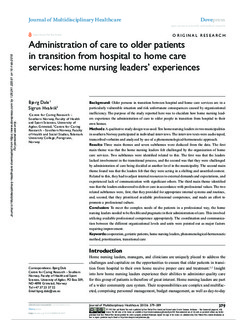| dc.contributor.author | Dale, B. | |
| dc.contributor.author | Hvalvik, S. | |
| dc.date.accessioned | 2018-02-19T13:10:08Z | |
| dc.date.available | 2018-02-19T13:10:08Z | |
| dc.date.issued | 2013 | |
| dc.identifier.citation | Dale, B. & Hvalvik, S. (2013). Administration of care to older patients in transition from hospital to home care services: Home nursing leaders’ experiences. Journal of Multidisciplinary Healthcare, 6, 379-389. | nb_NO |
| dc.identifier.uri | http://hdl.handle.net/11250/2485698 | |
| dc.description.abstract | Background: Older persons in transition between hospital and home care services are in a particularly vulnerable situation and risk unfortunate consequences caused by organizational inefficiency. The purpose of the study reported here was to elucidate how home nursing leaders experience the administration of care to older people in transition from hospital to their own homes.
Methods: A qualitative study design was used. Ten home nursing leaders in two municipalities in southern Norway participated in individual interviews. The interview texts were audio taped, transcribed verbatim and analyzed by use of a phenomenological-hermeneutic approach.
Results: Three main themes and seven subthemes were deduced from the data. The first main theme was that the home nursing leaders felt challenged by the organization of home care services. Two subthemes were identified related to this. The first was that the leaders lacked involvement in the transitional process, and the second was that they were challenged by administration of care being decided at another level in the municipality. The second main theme found was that the leaders felt that they were acting in a shifting and unsettled context. Related to this, they had to adjust internal resources to external demands and expectations, and experienced lack of communication with significant others. The third main theme identified was that the leaders endeavored to deliver care in accordance with professional values. The two related subthemes were, first, that they provided for appropriate internal systems and routines, and, second, that they prioritized available professional competence, and made an effort to promote a professional culture.
Conclusion: To meet the complex needs of the patients in a professional way, the home nursing leaders needed to be flexible and pragmatic in their administration of care. This involved utilizing available professional competence appropriately. The coordination and communication between the different organizational levels and units were pointed out as major factors requiring improvement. | nb_NO |
| dc.publisher | Journal of Multidisciplinary Healthcare | nb_NO |
| dc.rights | Navngivelse-Ikkekommersiell 4.0 Internasjonal | * |
| dc.rights.uri | http://creativecommons.org/licenses/by-nc/4.0/deed.no | * |
| dc.subject | cooperation | nb_NO |
| dc.subject | geriatric patients | nb_NO |
| dc.subject | home nursing leaders | nb_NO |
| dc.subject | phenomenological-hermeneutic method | nb_NO |
| dc.subject | prioritization | nb_NO |
| dc.subject | transitional care | nb_NO |
| dc.title | Administration of care to older patients in transition from hospital to home care services: Home nursing leaders’ experiences | nb_NO |
| dc.type | Journal article | nb_NO |
| dc.source.pagenumber | 379-389 | nb_NO |
| dc.source.volume | 6 | nb_NO |
| dc.source.journal | Journal of Multidisciplinary Healthcare | nb_NO |
| dc.identifier.doi | 10.2147/JMDH.S51947 | |

